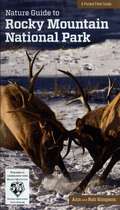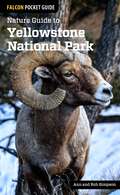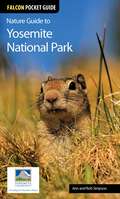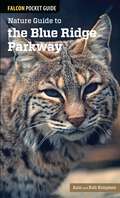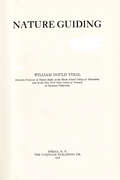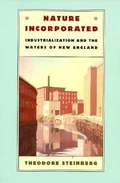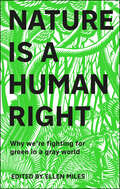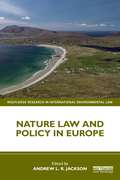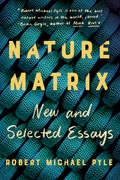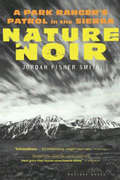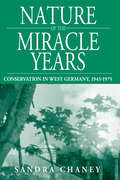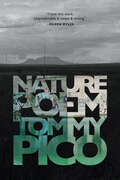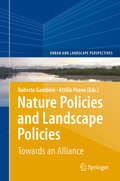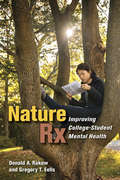- Table View
- List View
Nature Guide to Acadia National Park (Nature Guides to National Parks Series)
by Rob Simpson Ann SimpsonThis field guide dedicated to wildlife of Acadia National Park is an information-packed book that introduces park visitors to animals, plants, insects, and more that reside in the area in a colorful, easy-to-use package. Including full-color photos and easy-to-understand descriptions and with full cooperation from the park association, this book will appeal to anyone interested in nature.
Nature Guide to Glacier and Waterton Lakes National Parks
by Amy GrisakGlacier National Park, known as the "Crown of the Continent," is a stunningly beautiful mountain landscape adorned with glaciers and snowfields. Combined with its sister park, Waterton Lakes Park in southern Alberta, the two become Waterton-Glacier International Peace Park, the first of its kind in the world. These wild places are the realm of the grizzly and the mountain goat, along with the diminutive pika and delicate, yet exceptionally hardy, wildflowers that put on a dazzling display in the short season between the months of snow. Visitors to Glacier and Waterton have a lot of questions about the native flora and fauna, and there isn&’t a ranger around every corner to answer them. Nature Guide to Glacier and Waterton National Parks will be their handy resource to quickly identify over 200 animals and plants native to the parks. Conveniently sized to fit in a pocket, look inside for full-color images, detailed descriptions, useful park information, and much more as you explore the unique wildlife and nature of Glacier and Waterton Lakes National Parks.
Nature Guide to Rocky Mountain National Park (Nature Guides to National Parks Series)
by Rob Simpson Ann SimpsonThis field guide dedicated to the wildlife of Rocky Mountain National Park is an information-packed, pocket-sized book that introduces park visitors to animals, plants, insects and more that reside at Rocky Mountain National Park in a colorful and portable package. Includes more than 200 species, including elk, bighorn sheep, moose, ptrarmigan, pika, American dipper, greenback cutthroat trout, aspen, fairy slipper, Colorado columbine, mountain pine beetle, and more.
Nature Guide to Shenandoah National Park
by Rob Simpson Ann SimpsonThis field guide dedicated to wildlife of Shenandoah National Park is an information-packed book that introduces park visitors to animals, plants, insects and more that reside in the Shenandoah Valley in a colorful, easy-to-use package. Including full-color photos and easy-to-understand descriptions and with full cooperation from the park association, this book will appeal to the 1.1 million visitors who travel to Shenandoah every year.
Nature Guide to Shenandoah National Park (Nature Guides to National Parks Series)
by Rob Simpson Ann SimpsonThis field guide dedicated to wildlife of Shenandoah National Park is an information-packed, pocket-sized book that introduces park visitors to animals, plants, insects and more that reside in the Shenandoah Valley in a colorful and portable package. Including full-color photos and easy-to-understand descriptions and with full cooperation from the park association, this book will appeal to the 1.1 million visitors who travel to Shenandoah every year.
Nature Guide to Yellowstone National Park (Nature Guides to National Parks Series)
by Rob Simpson Ann SimpsonThis field guide dedicated to wildlife of Yellowstone National Park is an information-packed, pocket-sized book that introduces park visitors to the animals, plants, insects and more that reside in Yellowstone National Park in a colorful and portable package. Published in cooperation with Yellowstone National Park Association, this Nature Guide to Yellowstone National Park contains full-color photos and easy-to-understand descriptions. Here is the perfect companion guide for the 3 million visitors who travel to Yellowstone National Park every year.
Nature Guide to Yosemite National Park (Nature Guides to National Parks Series)
by Rob Simpson Ann SimpsonThis field guide dedicated to wildlife of Yosemite National Park is an information-packed, pocket-sized book that introduces park visitors to the animals, plants, insects and more that reside in Yosemite National Park in a colorful and portable package. Published in cooperation with Yosemite National Park Association, this Nature Guide to Yosemite National Park contains full-color photos and easy-to-understand descriptions. Here is the perfect companion guide for the 4 million visitors who travel to Yosemite National Park every year.
Nature Guide to the Blue Ridge Parkway (Falcon Pocket Guides)
by Rob Simpson Ann SimpsonThe stunning wildlife along the Blue Ridge Parkway attracts more than 14 million annual visitors from near and far for viewing and photographing opportunities. This information-packed, pocket-size field guide features more than 200 species of mammals, birds, insects, fish, wildflowers, mushrooms and more in a convenient, portable package. Including full-color photos and easy-to-understand descriptions, species are arranged by family to aid in quick identification. This book also includes ecosystem and geology information about the park as well as suggested nature hikes. This is the perfect nature guide for your next trip to the Blue Ridge Parkway.
Nature Guiding
by William Gould VinalNature Guiding is the science of inculcating nature enthusiasm, nature principles, and nature facts into the spirit of individuals. "Doing" nature-study means observing, wondering, and solving problems. It could include collecting, building, measuring, painting, planning, writing, touching, experimenting or any of a wide range of other activities. Most importantly, it allows children to be "original investigators."This book is intended as a resource for teachers and students engaged in nature study at summer camps and in schools. William Gould Vinal believed that the teacher of nature study should be "in sympathy with the simple life and the country way," that the nature study should emphasize observation of the interactions of plants and animals in their environment, and not be reduced to matters of taxonomy and anatomy. In Nature Guiding, he offers advice to camp counselors and school teachers on incorporating nature study into everyday activities, as well as suggestions for parents and others about using visits to state and national parks to teach nature lore.
Nature Handbook
by DKA practical illustrated guide to exploring, observing, and understanding natureChris Packham will pass on his passion for nature and make you an enthusiastic and knowledgeable amateur naturalistChris Packham&’s Nature Handbook reveals how easy it is to enjoy and learn about plants, animals, habitats, and ecological processes. It features visual studies of habitats – full of photos of the animals and plants that live there and illustrations of how they interact. All the habitats in your region (Europe in the UK edition, or North America in the US edition) are included, from accessible urban and farming landscapes to wilderness areas. This book reveals the sights, sounds, and smells you can encounter and shows you how to connect with nature without intruding. It provides illustrated guides to activities for every season. Many of these, like pond dipping and raising butterflies from caterpillars, can be done close to home and without expensive equipment. The book promotes conservation and demonstrates simple ways to contribute to the health of the natural world.First published in 2010, this edition has been extensively revised to present more local information relevant to the habitats where you live, and to include the latest equipment and conservation issues. A blend of inspirational guide, essential reference, and &“how-to&”, this book will make you wild about the natural world.
Nature Incorporated: Industrialization and the Waters of New England
by Theodore SteinbergA great deal of arrogance surrounds this late-twentieth-century attitude toward the environment, and a great deal of history as well. What started as a research paper at Brandeis University expanded into a book that explores the role of the Industrial Revolution in this aggressive stance toward the natural world. The transformation of nature is at least as old as our presence as a species on this planet. But the advent of the industrial age marked a shift in humankind's relations with the earth. Steinberg concerns himself mainly with describing this shift as it was felt in New England, to journey back to a time when the task of subduing nature was full of hard-fought battles and much less arrogance.
Nature Is A Human Right: Why We're Fighting for Green in a Gray World
by Ellen MilesFighting for a green world — a collection of essays and writing for building an equal, healthier society. Access to the natural world is a human right. This inspiring book captures why contact with nature is essential for our mental, social and physical well-being — and how we can rethink urban development to create green city spaces and a return to nature.Find an inspiring collection of original writings from world-leading &“green&” voices and discover: • Benefits and issues surrounding our access to nature • Discussions on social and environmental justice • Why we need nature around us, how we&’re being deprived of nature and what we can all do to change environmental and social issues • Edited by the founder of the environmental justice campaign Nature is a Human Right, Ellen Miles Concrete outweighs every tree, bush, and shrub on Earth. Nature deprivation is a fast-growing epidemic, harming the health and happiness of hundreds of millions of people worldwide — especially vulnerable and marginalized groups. Nature is a Human Right, founded by Ellen Miles in 2020, is working to make access to green space a recognized right for all, not a privilege.This book brings together a collection of engaging, accessible essays, interviews and exercises, from expert ambassadors and supporters (including authors, artists, scientists, human rights experts, television presenters, TED speakers, and climate activists). Each contributor offers a new perspective on why contact with nature should be a protected human right. Enlightening and sometimes uncomfortable, this collection of writing and ideas illuminate the work that needs to be done to make our global future happier.
Nature Law and Policy in Europe (Routledge Research in International Environmental Law)
by Andrew L. R. JacksonThis volume considers current and future challenges for nature law and policy in Europe. Following the Fitness Check evaluation of the Birds and Habitats Directives, in 2017 the EU adopted an Action Plan for nature, people and the economy to rapidly improve the Directives’ implementation and accelerate progress towards the EU's biodiversity targets for 2020. More recently, the EU has adopted a Biodiversity Strategy for 2030 and proposed an EU Nature Restoration Law. This book makes a timely contribution by examining the current state of play in light of recent and historical developments, as well as the post-2020 nature law and policy landscape. While evidence suggests that Natura 2000 and the Habitats and Birds Directives have delivered conservation benefits for wildlife in Europe, biodiversity loss continues apace. The book reviews the requirements for an effective international nature conservation system, with reference to the Birds and Habitats Directives. It examines regulatory regimes, current legal issues in the fields of site protection and species protection, the protection of areas outside Natura 2000, recent developments in the EU and the UK, including the implications of Brexit, agriculture and nature conservation, litigation, science and access to justice. Written by leading experts in the field, from a range of stakeholder groups, the volume draws on diverse experiences as well as providing interdisciplinary perspectives. This volume will be essential reading for students, scholars, practitioners, NGOs and policy-makers interested in European environmental policy and law, including for example lawyers, ecologists, environmental scientists, political scientists, natural resource managers, planners and civil servants.
Nature Matrix: New and Selected Essays
by Robert Michael PyleNature Matrix is a gathering of some of Robert Michael Pyle’s most significant, original, and timely expressions of a life immersed in the natural world, in all its splendor, power, and perilNature Matrix: New and Selected Essays contains sixteen pieces that encompass the philosophy, ethic, and aesthetic of Robert Michael Pyle. The essays range from Pyle’s experience as a young national park ranger in the Sierra Nevada to the streets of Manhattan; from the suburban jungle to the tangles of the written word; and from the phenomenon of Bigfoot to that of the Big Year—a personal exercise in extreme birding and butterflying. They include deep profiles of John Jacob Astor I and Vladimir Nabokov, as well as excursions into wild places with teachers, children, and writers.The nature of real wilderness in modern times comes under Pyle’s lens, as does reconsideration of his trademark concept, “the extinction of experience”—maybe the greatest threat of alienation from the living world that we face today.Nature Matrix shows a way back toward possible integration with the world, as it plumbs the range and depth of experience in one lucky life lived in close connection to the physical earth and its denizens. This collection brings together the thoughts and hopes of one of our most widely read and respected natural philosophers as he seeks to summarize a life devoted to conservation.
Nature Needs You!: Join the Green Team and find out about the wonders of our natural world
by Liz GogerlyFour friends, Anjali, Lulu, Mason and Noah, discover an injured fox in the garden and need to take it to an animal rescue centre. There, they begin a year of discovery learning about the amazing animals, plants and places that make up our natural world.As the year goes on the children talk to lots of different people, from park rangers and environmentalists, to teachers and grandparents. They learn lots of things about the natural world, from biodiversity, food chains and climate change to pollination, plastic pollution and ecosystems.Throughout there are 'Take Action' advice panels, which give examples of small ways that people can get involved to help protect nature.Get Busy activity suggestions encourage children to be actively engaged with nature, by birdwatching or planting wild flowers.There are also full-page, step-by-step activities for how to make a bug hotel and a bird feeder.By the end of the book, readers will have a better understanding of the importance of nature, humans impact on nature and what can be done to help protect itLook out for the other titles in this series: Go Green, Wild Weather and Save our Seas.
Nature Noir: A Park Ranger's Patrol in the Sierra
by Jordan Fisher Smith&“A nature book unlike any other…peppered with gritty, anti-romantic, all-too-real tales of cops &’n&’ bad guys in the great outdoors.&”—The San Diego Union-Tribune Jordan Fisher Smith&’s startling account of fourteen years as a park ranger thoroughly dispels our idealized visions of life in the great outdoors. Instead of scout troops and placid birdwatchers, Smith's beat—a stretch of land that has been officially condemned to be flooded—brings him into contact with drug users tweaked out to the point of violence, obsessed miners, and other dangerous creatures. In unflinchingly honest prose, he both portrays the breathtaking natural world around him and reveals the unexpectedly dark underbelly of patrolling and protecting public lands. &“Gloriously unlike anything I&’ve ever read before…gives entree into a strange, dark, and mesmerizing outdoor world that's absolutely unforgettable.&”—The Boston Globe &“By turns funny, poignant and surprising…an intimate memoir of the career of a state-park ranger. Not just any ranger, but one with a wicked pen, patrolling a doomed landscape.&”—Seattle Times/Post-Intelligencer &“Compelling…refreshingly unsentimental.&”—Barry Lopez, author of Arctic Dreams &“Smith offers a fresh perspective on our threatened environment…Nature Noir reflects the spirit of an era as did Desert Solitaire.&”—Charlotte Observer
Nature Of The Miracle Years: Conservation in West Germany, 1945-1975 (Studies in German History #8)
by Sandra ChaneyAfter 1945, those responsible for conservation in Germany resumed their work with a relatively high degree of continuity as far as laws and personnel were concerned. Yet conservationists soon found they had little choice but to modernize their views and practices in the challenging postwar context. Forced to change by necessity, those involved in state-sponsored conservation institutionalized and professionalized their efforts, while several private groups became more confrontational in their message and tactics. Through their steady and often conservative presence within the mainstream of West German society, conservationists ensured that by 1970 the map of the country was dotted with hundreds of reserves, dozens of nature parks, and one national park. In doing so, they assured themselves a strong position to participate in, rather than be excluded from, the left-leaning environmental movement of the 1970s.
Nature Out of Balance: How Invasive Species Are Changing the Planet (Orca Footprints #19)
by Merrie-Ellen WilcoxInvasive species threaten local ecosystems and the planet’s biodiversity, but are they all as bad as we think they are? Plants, animals, insects and fish are moving in. In Nature Out of Balance:How Invasive Species Are Changing the Planet author Merrie-Ellen Wilcox profiles all-star invasive species around the world, starting in her own neighbourhood, and warns that humans are the most invasive species of all. We find out how and why species become invasive, what we can do to stop their spread and whether it’s time to think differently about invasive species that are here to stay.
Nature Out of Place: Biological Invasions In The Global Age
by Jason Van Driesche Roy Van DriescheThough the forests are still green and the lakes full of water, an unending stream of invasions is changing many ecosystems around the world from productive, tightly integrated webs of native species to loose assemblages of stressed native species and aggressive invaders. The earth is becoming what author David Quammen has called a "planet of weeds." Nature Out of Place brings this devastating but overlooked crisis to the forefront of public consciousness by offering a fascinating exploration of its causes and consequences, along with a thoughtful and practical consideration of what can be done about it. The father and son team of Jason and Roy Van Driesche offer a unique combination of narratives that highlight specific locations and problems along with comprehensive explanations of the underlying scientific and policy issues.Chapters examine Hawaii, where introduced feral pigs are destroying the islands' native forests; zebra mussel invasion in the rivers of Ohio; the decades-long effort to eradicate an invasive weed on the Great Plains; and a story about the restoration of both ecological and human history in an urban natural area. In-depth background chapters explain topics ranging from how ecosystems become diverse, to the characteristics of effective invaders, to procedures and policies that can help prevent future invasions. The book ends with a number of specific suggestions for ways that individuals can help reduce the impacts of invasive species, and offers resources for further information.By bringing the problem of invasive species to life for readers at all levels, Nature Out of Place will play an essential role in the vital effort to raise public awareness of this ongoing ecological crisis.
Nature Play Workshop for Families: A Guide to 40+ Outdoor Learning Experiences in All Seasons (Workshop For Kids Ser.)
by Monica Wiedel-Lubinski Karen MadiganNational Outdoor Book Award Winner: A fun, practical guide to outdoor play that sparks a connection to nature vital to children’s healthy development.Today children and families are often plugged into electronics and disconnected from direct experiences in nature. This beautifully photographed resource offers tangible approaches to nature-based learning and play for children. Parents and teachers can discover the benefits of outdoor learning and simple ways to facilitate unplugged nature connection in every season.Inspired by nature preschools, forest kindergartens, and forest school models the world over, this guide also includes “Voices from the Field” with advice from experienced nature-based educators. Balancing nature play experiences with hands-on projects using natural materials, it’s an ideal jumping off point for immersive nature play. Examples include: Wildlife observation and trackingNature sounds, songs, and poetryGardening and cooking with wild ediblesPrintmaking, charcoal drawing, dyeing, and shadow playJournaling inspired by nature“Voices from the Field” includes more ideas and tips contributed by leading educators, including:Sally Anderson, Sol Forest School, Tijeras, New Mexico * Yash Bhagwanji, Florida Atlantic University * Lauren Brown, Asheville Farmstead School * Peter Dargatz, Woodside Elementary School, Sussex, Wisconsin * Monica French, Wild Haven Forest Preschool and Childcare, Baltimore, Maryland * Patricia Leon, Miami Nature Playschool * Sheila William Ridge, Shirley G. Moore Lab School, Institute of Child Development, University of Minnesota * Beth Savitz, Irvine Nature Center, Owings Mills, Maryland * Maria Soboleski, New Mexico School for the Deaf * Paige Vonder Haar, Bunnell House Early Childhood Lab School, Fairbanks, Alaska * Susie Wirth, Arbor Day Foundation and Dimensions Foundation
Nature Play at Home: Creating Outdoor Spaces that Connect Children with the Natural World
by Nancy Striniste“A magnificent resource for transforming backyards into stimulating environments which enhance children’s creativity, learning, and fun.” —Richard Louv, author of Last Child in the Woods, The Nature Principle, and Vitamin N Access to technology has created a generation of children who are more plugged in than ever before—often with negative consequences. But there is a solution. Unrestricted outdoor play helps reduce stress, improve health, and enhance creativity, learning, and attention span. In Nature Play at Home, Nancy Striniste gives you the tools you need to make outdoor adventures possible in your own backyard. With hundreds of inspiring ideas and illustrated, step-by-step projects, this hardworking book details how to create playspaces that use natural materials—like logs, boulders, sand, water, and plants of all kinds. Projects include hillside slides, seating circles, sand pits, and more.
Nature Poem
by Tommy PicoA book-length poem about how an American Indian writer can’t bring himself to write about nature, but is forced to reckon with colonial-white stereotypes, manifest destiny, and his own identity as an young, queer, urban-dwelling poet. A Best Book of the Year at BuzzFeed, Interview, and more. Nature Poem follows Teebs—a young, queer, American Indian (or NDN) poet—who can’t bring himself to write a nature poem. For the reservation-born, urban-dwelling hipster, the exercise feels stereotypical, reductive, and boring. He hates nature. He prefers city lights to the night sky. He’d slap a tree across the face. He’d rather write a mountain of hashtag punchlines about death and give head in a pizza-parlor bathroom; he’d rather write odes to Aretha Franklin and Hole. While he’s adamant—bratty, even—about his distaste for the word “natural,” over the course of the book we see him confronting the assimilationist, historical, colonial-white ideas that collude NDN people with nature. The closer his people were identified with the “natural world,” he figures, the easier it was to mow them down like the underbrush. But Teebs gradually learns how to interpret constellations through his own lens, along with human nature, sexuality, language, music, and Twitter. Even while he reckons with manifest destiny and genocide and centuries of disenfranchisement, he learns how to have faith in his own voice.
Nature Policies and Landscape Policies
by Attilia Peano Roberto GambinoThe book focuses on the relationship between nature conservation policies and landscape policies. This is a relevant subject due to the current need of reviving nature conservation policies, which are today affected by a general effectiveness deficiency. To this end, landscape policies can play a crucial role, bridging nature and culture, fostering more integrated approaches to nature conservation and stimulating the active participation of local communities. The book gathers reflections, researches and experiences developed on an international level on this subject by experts coming from different international contexts (Europe, U. S. A. ), various disciplinary backgrounds (geographers, planners, biologists, historians, jurists, economists, etc. ) and several institutional bodies (Universities, administrative bodies, international organizations such as IUCN, EUROPARC Federation, UNESCO, etc. ). The overall reflections gathered in the book - which is divided in three main sections: regulations and institutional frameworks, policies, actions and tools - combine to suggest innovative visions about the relationships between nature policies and landscape policies.
Nature Rx: Improving College-Student Mental Health
by Donald A. Rakow Gregory T. EellsThe Nature Rx movement is changing campus life. Offering alternative ways to deal with the stress that students are under, these programs are redefining how to provide students with the best possible environment in which to be healthy, productive members of the academic community. In Nature Rx, Donald A. Rakow and Gregory T. Eells summarize the value of nature prescription programs designed to encourage college students to spend time in nature and to develop a greater appreciation for the natural world. Because these programs are relatively new, there are many lessons for practitioners to learn; but clinical studies demonstrate that students who regularly spend time in nature have reduced stress and anxiety levels and improved mood and outlook.In addition to the latest research, the authors present a step-by-step formula for constructing, sustaining, and evaluating Nature Rx programs, and they profile four such programs at American colleges. The practical guidance in Nature Rx alongside the authors' vigorous argument for the benefits of these programs for both students and institutions places Rakow and Eells at the forefront of this burgeoning movement.
Nature Sparks
by Aerial CrossNature has monumental power on children's growth and development. Recent studies show that as children spend less time in nature, they miss out on the profound benefits that outdoor play and learning experiences provide.Nature Sparks is filled with inspiration and instruction to help educators and caregivers of children ages three to eight reclaim and strengthen connections to the outdoors. This resource supplies ideas to create a nature-oriented classroom and curriculum, incorporates Howard Gardner's theory of multiple intelligences to encourage children's individual talents as they experience the natural world, and includes more than fifty sensory-integrated activities, crafts, and instructional strategies.


